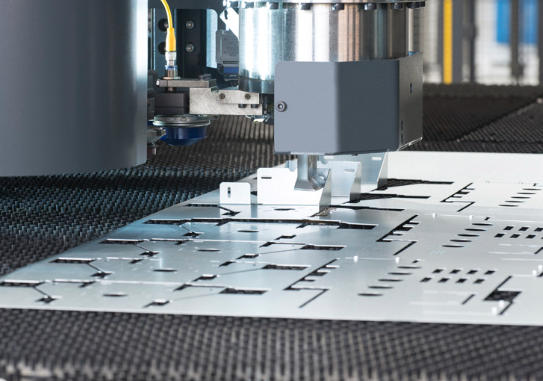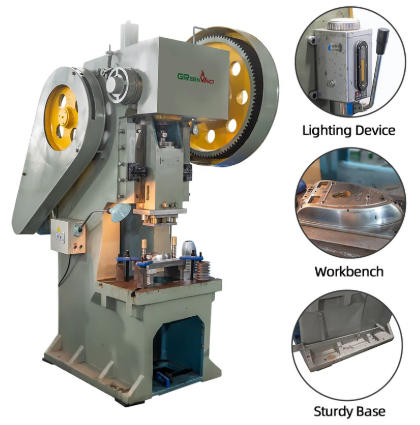Views: 222 Author: Rebecca Publish Time: 2025-11-18 Origin: Site









Content Menu
● Understanding the Punch Press Machine
● Why the Cutlery Industry Depends on Punch Press Machines
● Major Benefits of Investing in a Punch Press Machine
>> 1. Exceptional Precision and Repeatability
>> 2. Dramatic Improvement in Production Efficiency
>> 3. Flexibility for Multiple Cutlery Designs
>> 4. Reduced Operational Costs
>> 5. Consistent Surface Quality and Less Finishing Work
● Integration with Smart Factory Ecosystems
● Environmental Impact and Sustainability
● Case Example: Upgrading a Cutlery Factory's Production Line
● Technological Advancements Supporting the Cutlery Sector
>> Multi-Station Turret Punch Systems
>> Servo-Electric Motor Drives
>> AI-Driven Monitoring and Predictive Maintenance
● Competitive Advantages for Global Manufacturers
● Future Outlook for Punch Press Technology in Cutlery Manufacturing
● FAQ
>> 1. What are the main advantages of using a punch press machine in cutlery production?
>> 2. How does a servo-electric punch press save energy compared to older models?
>> 3. Can the same punch press be used for knives, forks, and spoons?
>> 4. Are punch press systems environmentally friendly?
>> 5. How long does it take to achieve a return on investment for a punch press?
In today's fast-paced manufacturing world, precision and efficiency define success. The cutlery industry, in particular, demands exceptionally high accuracy due to the fine balance and detailed design of every knife, fork, and spoon. Manufacturers are constantly seeking advanced equipment that can meet these requirements while maintaining competitive costs and sustainable operations. This is where the punch press machine has revolutionized cutlery production.
A punch press machine combines engineering precision with automation, allowing factories to shape and form metal quickly, consistently, and cleanly. It helps manufacturers produce large volumes of cutlery with near-perfect uniformity and minimum waste. For production managers and factory owners, investing in a modern punch press machine is a crucial step toward scaling capacity, improving quality, and staying ahead in the global marketplace.
This article explores the extensive benefits of punch press machines, their role in transforming modern cutlery manufacturing, and how such an investment can lead to long-term operational excellence.

A punch press machine is designed to shape sheet metal into precise components by applying mechanical or hydraulic force using specialized tools and dies. Each stroke of the press punches, cuts, bends, or embosses the metal to create desired patterns or forms. Modern CNC punch presses can execute multiple operations automatically using one setup program, greatly enhancing accuracy and speed.
In the context of cutlery manufacturing, these machines are vital for cutting stainless-steel sheets into knife blades, spoon heads, and fork tines. Once shaped, these blanks proceed to polishing and finishing stages. The advantage of CNC control lies in repeatability—every piece comes out identical to the last, ensuring consistency across thousands of items produced daily.
The cutlery production process has evolved from manual forging and grinding to automated high-speed operations. Punch press machines form the backbone of this evolution due to several core capabilities that match industry needs:
- High-speed blanking and forming of stainless steel and titanium sheets.
- Ability to perform decorative embossing and engraving.
- Consistent product thickness and smooth surface finish.
- Integration with robotic handlers in automated lines.
Factories that adopt this equipment experience shorter production cycles, fewer defects, and reduced labor dependency—making them more competitive internationally.
Precision is essential when producing utensils that must balance perfectly and look identical. Punch press machines provide unmatched accuracy by maintaining stable pressure across the die every time. The precision tolerance can often be within microns, ensuring that each cutlery piece conforms to the exact design specification.
Modern CNC systems continuously monitor operations, adjusting for variables like sheet resistance or thickness variation. This real-time control ensures remarkably consistent results, reducing post-processing time and defect rates.
Efficiency directly translates into profitability. A single fully-automated punch press can produce thousands of utensil blanks in an hour. The ability to perform multiple operations in a single cycle—cutting, forming, bending, and embossing—accelerates output while minimizing changeover times between product batches.
Automation also allows 24/7 continuous operation with minimal downtime. Equipped with robotic feeders and parts collectors, these systems reduce idle time and allow uninterrupted workflows that maximize overall throughput.
Customer tastes in cutlery are highly dynamic. Restaurants, hotels, and retailers demand unique shapes, engravings, and finishes. Punch press technology grants flexibility through easy programming adjustments. A single machine can handle varying designs—such as square handles, rounded spoons, or engraved knife blades—without requiring extensive retooling.
By shortening design-to-production time, factories can respond faster to market trends and produce tailored collections that appeal to specific clients or regions.
Investing in a punch press machine significantly cuts both material and operational costs. Traditional forging processes use intense heat and manual shaping, which consume high energy and labor resources. In contrast, servo-electric punch presses use direct-drive motors that activate only when needed, consuming up to 50 percent less energy.
Moreover, advanced nesting software arranges part layouts on metal sheets to minimize waste. The reduced scrap rate and lower need for manual labor combine to yield rapid financial returns and reduced per-unit production costs.
Because punch presses apply uniform force, surfaces come out smooth and free of cracks or irregular deformations. This consistency reduces the amount of manual polishing and finishing needed later. As a result, production time decreases, while the end product achieves a more refined and visually appealing finish right off the press.
The Fourth Industrial Revolution has introduced intelligent, data-driven solutions to manufacturing. Punch press machines are now fully compatible with these smart factory systems, allowing seamless integration across production lines.
1. Design Phase: Engineers create digital 3D models using CAD software.
2. Programming: Design files are directly uploaded to the CNC machine.
3. Production: Automated feeders deliver sheets, and robotic arms remove finished blanks.
4. Data Collection: Sensors track performance metrics like stroke count, pressure, and vibration.
5. Analysis: Collected data helps optimize energy use, predict maintenance, and improve efficiency.
This integration allows cutlery manufacturers to operate with minimal human supervision, achieving continuous and traceable production cycles that meet global quality assurance standards.

Sustainability is more than a buzzword—it is now a production imperative. Punch press technology supports eco-friendly operations in several vital ways:
- Material Efficiency: Optimized punching algorithms allow the most efficient use of each metal sheet.
- Reduced Waste: Scrap collection systems ensure that leftover metal is fully recyclable.
- No Hydraulic Oil Pollution: Servo-electric drives eliminate the risk of oil leaks, promoting cleaner work environments.
- Energy Conservation: Modern press motors draw power on demand rather than continuously, significantly lowering energy consumption.
Factories adopting these green practices enjoy improved brand image and compliance with environmental certifications essential for exporting to regulated markets.
Consider a mid-sized cutlery manufacturer producing stainless steel utensils for export. Before modernization, their mechanical stamping presses required heavy manual intervention and frequent maintenance, resulting in inconsistent quality and production delays.
After investing in two servo-electric CNC punch press machines integrated with robotic sheet feeders, the factory achieved:
- 40 percent reduction in energy use.
- 25 percent faster production cycles.
- 15 percent improvement in material yield.
- Fully automated operation across three shifts.
This transition allowed them to meet growing overseas orders while maintaining excellent precision, reducing environmental impact, and enhancing profitability within a year.
These allow simultaneous tooling setups, drastically reducing downtime. Workers can switch between utensil types—such as spoons or forks—without manual reconfiguration.
These energy-efficient solutions provide smoother operation, precise motion control, and quieter working environments than traditional hydraulic presses.
By using sensors and machine learning algorithms, modern presses detect anomalies during operation. This predictive maintenance model extends tool life, avoids breakdowns, and maximizes productivity.
Collaborative robots integrate directly with punching lines to handle raw material inputs, transfer cut parts, and stack finished items. This reduces ergonomic strain on human workers and ensures continuous cycle flows.
Punch press technology allows cutlery manufacturers to compete effectively on three main fronts: quality, cost, and customization. Global buyers seek reliable partners capable of delivering consistent quality at scale. Automated presses meet these criteria by providing:
- Uniform product aesthetics essential for hospitality clients.
- Lowered operational costs for better profit margins.
- Capability to adapt quickly to new designs or branding requirements.
- Compliance with food safety and industrial production standards.
For export-oriented factories, these capabilities translate into a stronger reputation and prolonged business partnerships.
As digital manufacturing continues advancing, punch press systems will become even more interconnected and adaptive. Expected developments include:
- Digital Twin Simulation: Virtual modeling of pressing operations for optimizing setup parameters before production.
- Real-Time Cloud Monitoring: Remote system control and diagnostics for global plant networks.
- Integrated Laser-Punch Hybrids: Combining laser cutting with mechanical pressing for complex designs and faster precision cutting.
- Automated Tool Adjustment: Intelligent recognition of die wear, with automatic recalibration for consistent results.
The next generation of cutlery factories will operate as fully autonomous environments, where data analytics, robotics, and smart machinery collaborate to produce flawless utensils sustainably and efficiently.
Investing in a punch press machine signifies progress, efficiency, and readiness for the future of manufacturing. In the cutlery industry, where exact geometry, smooth surfaces, and large-scale consistency are non-negotiable, this equipment transforms how factories operate.
By integrating modern punch press systems, manufacturers achieve faster outputs, better energy use, superior design flexibility, and consistent quality—all under an environmentally responsible framework. The result is a leaner, more competitive production operation capable of meeting global demand with precision and confidence.
Punch press technology is not just a machinery upgrade; it is a strategic investment in innovation and long-term sustainability. Factories that adopt it today will lead tomorrow's market in speed, quality, and intelligent manufacturing.

It offers precision shaping, reduced waste, high speed, and flexibility to manufacture different designs. These machines ensure uniformity and reduce manual labor.
Servo-electric drives use electricity only during pressing cycles and have no hydraulic oil systems. This design significantly lowers energy consumption and maintenance costs.
Yes. CNC punch presses allow tool changes and digital reprogramming to adapt for various cutlery shapes within a single machine setup.
Modern presses are energy-efficient, recyclable, and free from hydraulic fluids, making them much cleaner and more sustainable than older forge or hydraulic systems.
Depending on output volume, ROI can often be realized within one to two years through reduced operating costs, energy savings, and expanded production capacity.
Why The Right Punch Press Machine Is Crucial for High-Quality Tableware Production?
Punch Press Machines: The Backbone of Efficient Cutlery Production
How To Choose Between Manual And Automatic Punch Press Machines?
Best Punch Press Machines for Small And Large-Scale Manufacturers
Top Manufacturers of Punch Press Machines for The Tableware Industry
What Are The Key Benefits of Investing in A Punch Press Machine for Your Factory?
How Punch Press Machines Are Revolutionizing The Cutlery Industry?
The Role of Punch Press Machines in Modern Kitchenware Production Lines
Punch Press Machine Vs. Turret Punch Press: What's The Difference?
